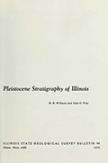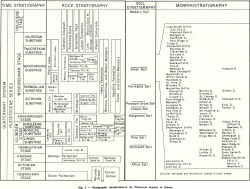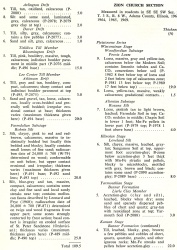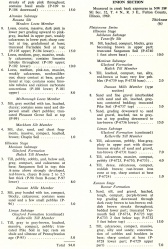Historical:Afton Soil
Lithostratigraphy: Afton Soil
Chronostratigraphy: Cenozoic Erathem >>Quaternary System >>Pleistocene Series
Authors
H. B. Willman and John C. Frye
Name origin
The Afton Soil is the lowest named soil-stratigraphic unit in the Pleistocene of Illinois (fig. 1). The name is derived from the Aftonian Stage, which was first described
by Chamberlin in 1895 from exposures in a gravel pit near Afton Junction, Union County, Iowa. The gravels at that locality are between two tills, subsequently correlated with the Kansan and Nebraskan, but no well developed zonal soil occurs between them.
The name Afton was retained because of the long-established use of Aftonian for the interglacial stage, in spite of the absence of the soil at the original type locality and considerable uncertainty concerning the age of the till in Union County, Iowa (Kay and Apfel, 1929, p. 191).
Type section
The Afton Soil as a formal soil-stratigraphic unit was introduced by Frye and Leonard in 1952 and described from a typical exposure in the Iowa Point geologic section in Doniphan County, Kansas. In Illinois the Afton Soil is based on a strongly developed soil (Zion Church Section, table 6) in a stratigraphic position below till correlated with the Kansan till of Iowa and Kansas (Willman, Glass, and Frye, 1963; Frye, Willman, and Glass, 1964), and it is developed in deposits correlated with the Nebraskan Stage.
| Table 6 -- Stratigraphic Sections (partial) The following 21 stratigraphic sections describe exposures in Illinois and illustrate many of the aspects of Pleistocene stratigraphy. These sections contain the type localities for 21 rock-stratigraphic units, 4 soil-stratigraphic units, and 3 time-stratigraphic units and include paratypes for several other units. The sample numbers preceded by "P" are the numbers used in the Illinois State Geological Survey collections. Analytical data on many of these samples are on file at the Survey. The sections are arrange alphabetically by name. |
Extent and thickness
The Afton Soil has been observed at only a few outcrops in Illinois and in a few borings in west-central Illinois. It has considerable stratigraphic significance, permitting the correlation of this early Pleistocene datum westward across Iowa and the Great Plains.
Lithology
No Afton Soil accretion-gleys have been observed in Illinois. Deposits of organic silt below till of Kansan age at the Mill Creek Section in Adams County (table 7)
may represent an accreted Afton Soil. If so, the soil lacks the distinctive character and high clay content of the accretion-gleys of the younger soils. At the Zion Church
Section, the Afton is a deep in-situ soil profile developed in outwash of Nebraskan age. Its B-zone is red-brown to red, strongly impregnated with heterogeneous swelling
clay minerals that are indicative of intensive or prolonged weathering to a depth of more than 5 feet below an upper contact that has been truncated to the B2-zone.
A deeply truncated Afton Soil is exposed in a few sections along the west side of the Illinois River Valley (e.g., Enion Section, table 6; Rushville (2.4 W), table 7), but it is difficult to evaluate the profile characteristics from these exposures.
| Table 6 -- Stratigraphic Sections (partial) The following 21 stratigraphic sections describe exposures in Illinois and illustrate many of the aspects of Pleistocene stratigraphy. These sections contain the type localities for 21 rock-stratigraphic units, 4 soil-stratigraphic units, and 3 time-stratigraphic units and include paratypes for several other units. The sample numbers preceded by "P" are the numbers used in the Illinois State Geological Survey collections. Analytical data on many of these samples are on file at the Survey. The sections are arrange alphabetically by name. |
References
CHAMBERLIN, T. C, 1895, The classification of American glacial deposits: Journal of Geology, v. 3, p. 270-277.
FRYE, J. C, and A. B. LEONARD, 1952, Pleistocene geology of Kansas: Kansas Geological Survey Bulletin 99, 230 p.
FRYE, J. C, H. B. WILLMAN, and H. D. GLASS, 1964, Cretaceous deposits and the Illinoian glacial boundary in western Illinois: Illinois State Geological Survey Circular 364, p. 28.
KAY, G. F., and E. T. APFEL, 1929, The pre-Illinoian Pleistocene geology of Iowa: Iowa Geological Survey, v. 34, p. 1-304.
WILLMAN, H. B., H. D. GLASS, and J. C. FRYE, 1963, Mineralogy of glacial tills and their weathering profiles in Illinois. Part I— Glacial tills: Illinois State Geological Survey Circular 347, 55 p.
ISGS Codes
| Stratigraphic Code | Geo Unit Designation |
|---|---|





